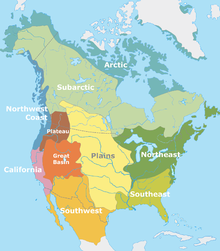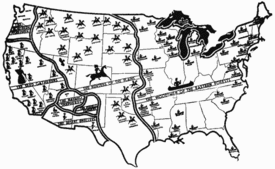- Cultural area
-
A cultural area or culture area is a region (area) with one relatively homogeneous human activity or complex of activities (culture). These areas are primarily geographical, not historical (but see below), and they are not considered equivalent to Kulturkreis (Culture circles).
Contents
Development
A culture area is a concept in cultural anthropology where a geographic region and time sequence (age area) is characterized by substantially uniform environment and culture.[1] The concept of culture areas was originated by museum curators and ethnologists during the late 1800s as means of arranging exhibits. Clark Wissler and Alfred Kroeber further developed the concept on the premise that they represent long-standing cultural divisions.[2][3][4] The concept is criticized by some, who argue that the basis for classification is arbitrary. But other researchers disagree and the organization of human communities into cultural areas remains a common practice throughout the social sciences.[1] The definition of culture areas is enjoying a resurgence of practical and theoretical interest as social scientists conduct more research on processes of cultural globalization.[5]
Music
A music area is a cultural area defined according to musical activity, and may or may not conflict with the cultural areas assigned to a given region. The world may be divided into three large music areas, each containing a "cultivated" or classical musics "that are obviously its most complex musical forms," with, nearby, folk styles which interact with the cultivated, and, on the perimeter, primitive styles[6]:
- Europe and Sub-Saharan Africa
- North Africa, Southwest Asia, South Asia, and Indonesia.
- American Indian, East Asia, Northern Siberian, and Finno-Ugric music
- based on shared large steps in pentatonic and tetratonic scales.
However, he then adds that "the world-wide development of music must have been a unified process in which all peoples participated," and that one finds similar tunes and traits in puzzlingly isolated or separated locations throughout the world.[6]
See also
- Culture areas of North America
- List of music areas in the United States
- Sprachbund
- Julian Steward
- Melville J. Herskovits
References
- ^ a b Brown, Nina "Friedrich Ratzel, Clark Wissler, and Carl Sauer: Culture Area Research and Mapping" University of California, Santa Barbara, CA. Webarchive of http://www.csiss.org/classics/content/15;
- ^ Wissler, Clark (ed.) (1975) Societies of the Plains Indians AMS Press, New York, ISBN 0-404-11918-2 , Reprint of v. 11 of Anthropological papers of the American Museum of Natural History, published in 13 pts. from 1912 to 1916.
- ^ Kroeber, Alfred L. (1939) Cultural and Natural Areas of Native North America University of California Press, Berkeley, CA.
- ^ Kroeber, Alfred L. "The Cultural Area and Age Area Concepts of Clark Wissler" In Rice, Stuart A. (ed.) (1931) Methods in Social Science pp. 248-265. University of Chicago Press, Chicago;
- ^ Gupta, Akhil and James Ferguson (1997). Culture, Power, Place: Explorations in Critical Anthropology. Durham, NC: Duke University Press.
- ^ a b Nettl, Bruno (1956). Music in Primitive Culture, p.142-143. Harvard University Press.
Bibliography
- Philip V. Bohlman, Marcello Sorce Keller, and Loris Azzaroni (eds.), Musical Anthropology of the Mediterranean: Interpretation, Performance, Identity, Bologna, Edizioni Clueb – Cooperativa Libraria Universitaria Editrice, 2009.
- Marcello Sorce Keller, “Gebiete, Schichten und Klanglandschaften in den Alpen. Zum Gebrauch einiger historischer Begriffe aus der Musikethnologie”, in T. Nussbaumer (ed.), Volksmusik in den Alpen: Interkulturelle Horizonte und Crossovers, Zalzburg, Verlag Mueller-Speiser, 2006, pp. 9–18
Categories:
Wikimedia Foundation. 2010.


